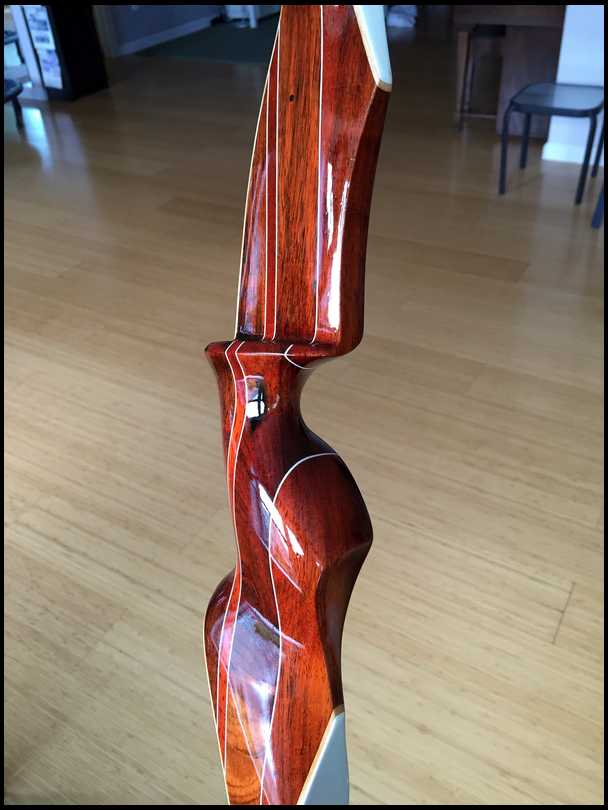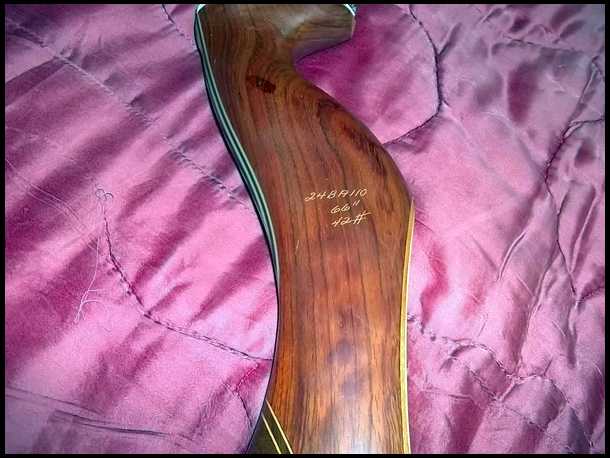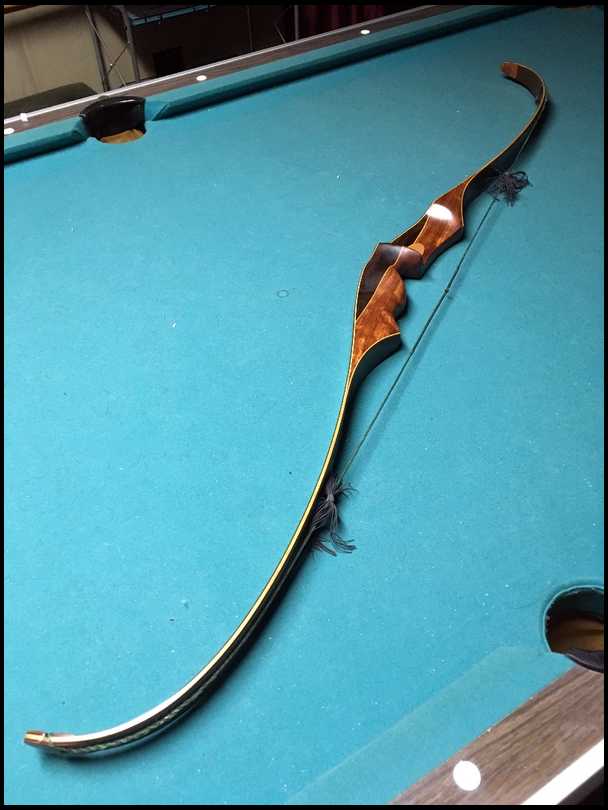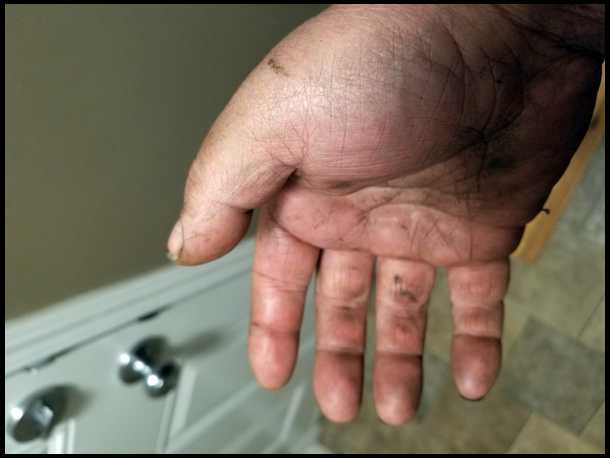| From: garnet65
|
|
|
|
|
|
|
| Date: 16-Nov-17 |
|
I want to refresh an old Bear Polar longbow for a friend of mine, and thought using Tru-Oil would be a good idea.
I have viewed a few YouTube videos about how to apply it, and it seems there is more than one way to do it. From using your bare finger to dabbing tissue paper in it then covering the tissue paper with a lint-free cloth and then applying it. Also be sure to apply it thinly.
Those of you who have successfully treated a vintage longbow with Tru-Oil, please tell me your method (in detail), and also any tricks or tips you can pass on.
Thanks in advance to those who respond.
Shoot 'em straight. Thanks.
Regards, WMM
|
|
| From: Phil Magistro
|
|
|
|
|
|
|
| Date: 16-Nov-17 |
|

I use a small piece of cotton cloth with a tight weave and put a light coat on the now. I let it dry - usually overnight and go over the bow lightly with 0000 steel wool. The wipe the bow with a tack cloth and repeat. If I'm doing only TruOil I usually put at least 8 coats on the bow. If you want to make it look better, wait 30 days for the oil to cure and wet sand with 1500, then 2000 grit paper.
Sometimes if the original finish is OK I'll sand it with 400 or 600 grit and apply only a few coats of TruOil using the same process as above.
And other times I'll apply a few spray coats of some finish, the type isn't important to me, wet sand the bow with 400 or 600 grit, depending on the amount of orange peel,then do the same as above with a few coats of TruOil. Of all three I prefer this method if I'm doing it for a high gloss shine and do not want to spend the time with other finishes.
|
|
| From: RymanCat
|
|
|
|
|
|
|
| Date: 16-Nov-17 |
|
Now that's really nice Phil. Beautiful.
|
|
| From: M60gunner
|
|
|
|
|
|
|
| Date: 16-Nov-17 |
|
Phil, that is outstanding!! Question, when you do final wetsand after 30 days do you wet the sandpaper with? Wax, water or ? Thank you TomM
|
|
| From: Thin Man
|
|
|
|
|
|
|
| Date: 16-Nov-17 |
|
Phil has described an excellent procedure for applying Tru-Oil.
I used to use folded paper towels to apply the oil, but since switched to the folded square of cotton cloth (I cut up t-shirts) method. If you punch a very (very!) tiny hole into the foil of the Tru-Oil bottle and trickle the oil minimally and evenly across the cloth, it is virtually impossible to leave a drip in the finish ... a blessing in itself!
Phil sands, whereas I like to rub the finish with either pumice or rottenstone (in mineral oil) once the Tru-Oil has sufficiently cured for the long period that Phil mentions. I'm not a good sander, and therefore have found the rubbing method more suitable for me in order to bypass my innate clumsiness with paper grit.
Phil mentions eight coats, and I have also found that to be a satisfactory minimum. We're talking uber-thin coats, and you won't find the finish beginning to look "deep" and "glassy" until you get fairly close to that number of coats. Personal taste after that number, of course, but I usually call it a day between eight and ten coats.
Tru-Oil is a wondrous finish, especially for spray-challenged folks such as myself. Hands-on all the way, and you can temper the final sheen as you see fit. Smells good, too, and can be performed indoors without unduly stinking up the room.
|
|
| From: M60gunner
|
|
|
|
|
|
|
| Date: 16-Nov-17 |
|
Thank you Thin Man. I am always on the look out for different methods of doing finishes. In the past I have used Tru Oil to finish bamboo fly rods. I have been using fine and extra fine rub out cream like used to rub out a car that’s been painted. It works but my Supply has gone south and I am not wanting to buy those large containers agian. Thanks agianfor the tip.
|
|
| From: hunterbob
|
|
|
|
|
|
|
| Date: 16-Nov-17 |
|
Better to just use your finger tip to apply the true oil.
|
|
| From: Phil Magistro
|
|
|
|
|
|
|
| Date: 16-Nov-17 |
|
I don't use pumice but I do use Rottenstone at times.
Most of my wet sanding is with wet or dry sandpaper working up to very fine grits which are more polishing the bow than sanding. The final coat I use is a auto clear coat swirl remover. It brings the shine to life.
|
|
|
|
| From: Bob Rowlands
|
|
|
|
|
|
|
| Date: 16-Nov-17 |
|
~ two dozen coats of Truoil on my gunstocks. Three on my arrows is good enough. Like Phil said, thin coat and 0000 wool. First couple coats thinned so oil goes in deep. Then build.
|
|
| From: Bob Rowlands
|
|
|
|
|
|
|
| Date: 16-Nov-17 |
|
Yeah my gunstocks look like that. Too shiny for me though knock down with 0000 wool. A couple dozen coats is alot of work but does yield one suhweet finish though.
|
|
| From: deerhunt51
|
|
|
|
|
|
|
| Date: 17-Nov-17 |
|
Use a cheap 1" foam brush. Brush True Oil on bow. As soon as you have it all wet start where you began and wipe off with a lint free cotton rag. This leaves a dead flat coat of oil. Repeat every 24 hours until you have 6 or 7 coats, when you are satisfied you can either wipe a final light coat on with one finger for a high gloss finish or steel wool lightly with 0000 steel wool for a satin finish. If you decide you want to steel wool, it is best to wait a week for the oil to cure. You can also wet sand with wet or dry 600 grit paper at any time during the process to fix imperfections. I cut 1" squares of the sand paper and use the oil to wet the paper, after done sanding wipe with lint free rag.
|
|
| From: alex1987
|
|
|
|
|
|
|
| Date: 17-Nov-17 |
|
Ia tru-oil used on the glass fibre part of the limbs too, or just the wood? It seems strange to assume that the glass will absorb the oil... Cheers Alex
|
|
| From: camodave
|
|
|
|
|
|
|
| Date: 17-Nov-17 |
|
I know this was not the question and I know this mostly falls on deaf ears but I will post it for that one person who might try it. I prefer the similar product, GB Linspeed. Finger application rubbed out with the palm of my hand reminds me of how my dad finished gunstocks so I do it that way.
DDave
|
|
| From: camodave
|
|
|
|
|
|
|
| Date: 17-Nov-17 |
|

Phil, by the nature of his work, and probably just by nature is meticulous. I am, by nature, kind of haphazard. And I still think this bow turned out okay.
|
|
| From: Draven
|
|
|
|
|
|
|
| Date: 17-Nov-17 |
|

I've redone this BP-H70 using Birchwood Casey Tru-oil, sanded the riser with grits from 200 to 1000, applied with coton cloth 6 layers of tru-oil during 3 days (12 h between to dry between layers). It's a user though, not a safe queen to go further.
|
|
| From: ny yankee
|
|
|
|
|
|
|
| Date: 17-Nov-17 |
|
I once watched an old gunsmith apply Tru Oil to a stock he had repaired. It was bare wood. He would put his index finger over the bottle opening and tip the bottle. He would start by dabbing the oil on the wood, then start rubbing in small circles and cover an area about 4"x4". Then he would go over the same area straight, along the grain. He said he would do 20 to 30 coats of the whole stock this way. We never talked about sanding. I saw the gun later and it was really beautiful. Looked very expensive.
|
|
| From: Billy Shipp
|
|
|
|
|
|
|
| Date: 17-Nov-17 |
|
I've refinished lots of guns and bows with Tru Oil. I prefer to use my finger to apply it, always put on a minimum of 12 coats, let it all dry good about a month then lightly buff it out with 0000 steel wool, easy to go back and touch up if something gets scratched. I agree with just poking a small hole in the top as I only want a tiny bit at a time to come out and a small hole promotes a longer shelf life.
|
|
| From: Penny Banks
|
|
|
|
|
|
|
| Date: 17-Nov-17 |
|
Good advice. I can only add that I store my Tru Oil upside down so that any skin that forms is on the bottom of the bottle when I turn it upright to use.
|
|
| From: garnet65
|
|
|
|
|
|
|
| Date: 17-Nov-17 |
|
Thank you everyone that responded. I now have a good idea how to do it for my project. I knew I could depend on my fellow Leatherwallers to guide me correctly.
Shoot 'em straight, and be safe in all you do.
Regards, WMM
|
|
| From: Phil Magistro
|
|
|
|
|
|
|
| Date: 17-Nov-17 |
|
Penny brought up an excellent point. Store it upside down and you'll get a longer shelf life out of a bottle.
|
|
| From: Cameron Root
|
|
|
|
|
|
|
| Date: 17-Nov-17 |
|
I use a tight swatch of Carhertt t shirt.
|
|
| From: Thin Man
|
|
|
|
|
|
|
| Date: 17-Nov-17 |
|
Here's the Safety Data Sheet for Tru-Oil:
https://www.birchwoodcasey.com/getattachment/Resources/Safety-Data-Sheets/23123,-23035,-23132-Tru-Oil-Saftey-Data-Sheet.pdf.aspx
|
|
| From: Cameron Root
|
|
|
|
|
|
|
| Date: 17-Nov-17 |
|
Silly. Says to dip your finger in the cup. Tell them there silly. I use my fingers on snake skins and cotton on wood and my fingers touch that as well. Geez
|
|
| From: Cameron Root
|
|
|
|
|
|
|
| Date: 17-Nov-17 |
|
I bought a large bottle which was a mistake. This stuff goes a lot ways. I stored it in many positions. Ended up throwing a quarter of it out. The small bottles will be the way I buy now one at a time. Rooty
|
|
| From: Cameron Root
|
|
|
|
|
|
|
| Date: 17-Nov-17 |
|
Your telling us that use are fingers that that is silly. When clearly they show the use of fingers in there directions. Who are you to over rule the manufacturer in there directions and to call us Silly for doing so. I've fingered that stuff on a pile of arrows and bows along with gun stocks. Rooty
|
|
| From: Cameron Root
|
|
|
|
|
|
|
| Date: 17-Nov-17 |
|

My hands are covered in cutting oil most days and I have washed my hands in gas. Is that bad too?
|
|
| From: OhioSteve
|
|
|
|
|
|
|
| Date: 17-Nov-17 |
|
I don't think Cameron Root's grizzly bear hands are going to be anything anyways! :)
|
|
| From: OhioSteve
|
|
|
|
|
|
|
| Date: 17-Nov-17 |
|
absorbing anything
|
|
| From: deerhunt51
|
|
|
|
|
|
|
| Date: 18-Nov-17 |
|
If you want to extend self life, add marbles to keep full. Air is what causes problem, it matters little if the air is between lid and oil or oil and bottom of container.
|
|
| From: Cameron Root
|
|
|
|
|
|
|
| Date: 18-Nov-17 |
|
Lol guys like me will build and others won't. Call me silly and I'll laugh at you. Rooty
|
|
| From: Brad Lehmann
|
|
|
|
|
|
|
| Date: 18-Nov-17 |
|
I have tried all of the methods mentioned above. After the wood pores are filled I want the finish to go on flat and stay flat. It is very hard to lay on a flat layer with fingers because what happens is there are high spots that have to be sanded off. So I take my time and lay it on flat and only have to wet sand and level every six to eight coats. I let my fingers tell me when to sand as they can feel irregularities that the eye cannot see. I would call it wasteful to use fingers due to all of the finish that gets sanded off, but the fact of the matter is that TruOil does not maintain the ability to lay flat after it has been opened for a few weeks. I use the tiny hole in the foil method for about the first month, then open it up and put a little mineral spirits in so that I can continue to use that particular bottle. Once the thinning begins the shelf life ends rather quickly. I usually toss the stuff within a couple of weeks of needing to thin it unless I have some raw wood that needs filler in the pores. I would be happy to see a container change such as packaging the stuff in a syringe rather than a bottle. I believe that one little change would double the shelf life of the product.
|
|
| From: Ken Williams
|
|
|
|
|
|
|
| Date: 18-Nov-17 |
|
This is about the best timing ever of a thread to appear for me personally.
I just bought a bottle of Truoil last week to do a bow and a gunstock that I have been putting off for awhile. Lots of good tips here.
Thanks fellas Ken
|
|
| From: Ken Williams
|
|
|
|
|
|
|
| Date: 18-Nov-17 |
|
BTW Rooty, you are in good company using your finger. Thats how Larry Potterfield, President of MidwayUSA, does it too.
https://youtu.be/ZYyAlaDYxro
He has a good tip on how to make a "handle" on the stock so you can hold the stock while working on it.
Ken
|
|
| From: garnet65
|
|
|
|
|
|
|
| Date: 28-Dec-17 |
|
Just an update: The bow is a Bear Polar Longbow 64" 47# RH Serial# P8168 Grayling MI. I have done about 4 applications of Tru-Oil with very satisfying results. Made a 61" double loop string with homemade wool silencers. The bow is marked 47# (my draw weight) so I tuned the bow to shoot Easton Legacy 1916's at 28" (my usual arrow), and they fly like bullets - straight and flat.
I asked Bear Archery for some info, and they told me it was made in 1952 so this bow is 65 years old!! and is performing beautifully! They also sent me a copy of the catalog page which reads: "The Polar is a straight bow having shooting qualities usually found only in recurved bows. Made especially for target shooting for those who prefer the straight bow." Also "Faced and backed with Fiberglass." "Length 64 inches. Weights to 75 lbs [for a target bow?]. 28 inch draw limit. Double loop string. Registered and guaranteed. $29.50." Which by the way in today's dollars is equal to about $273!
Thought you might be interested. Have a very Happy New Year and shoot 'em straight and stay safe. Be well
Regards,
WMM
|
|
|
|
| From: Red Dogs
|

|
|

|
|
|
|
| Date: 28-Dec-17 |
|
No answers to the Q regarding using it on the glass limbs???? Good question. Should you?
|
|
| From: KDdog
|
|
|
|
|
|
|
| Date: 28-Dec-17 |
|
Tru oil is a great product. But start with the pore filler first and build up a slurry, then apply tru oil once the filler is cured. It won't require as many coats. I finish with their stock sheen. And yes, it works great on limbs also. Just take your time between coats for proper curing.
|
|
| From: sir misalots
|
|
|
|
|
|
|
| Date: 28-Dec-17 |
|
have refinished some guns. Used my finger, but also used towels and sandpaper to work it in and wipe the excess
Great finish when completed
|
|
| From: Orion
|

|
|

|
|
|
|
| Date: 28-Dec-17 |
|
I've used tru-oil in the past, but didn't get results like Phil's. I know now that a lot of the reason is I didn't apply as many coats. However, I also don't have a dust free environment. I've tried placing my riser under a cardboard box to dry after each coat of finish, but it still picks up small dust particles, perhaps during the application process itself.
Do these particles sand out or rub out (or at least become invisible) with enough coats of finish?
|
|
| From: Longcruise
|
|
|
|
|
|
|
| Date: 28-Dec-17 |
|
If your supply gets thick and headed towards the trash can, you can bring it back with mineral spirits.
Yes, put it on the glass.
I've used it on gunstocks and bows applying with fingers and it is really pretty easy to do.
For anything that may be exposed to the elements as sometimes is the case with our bows, Tru Oil and other oil finishes are down towards the bottom of the list.
|
|
| From: Phil Magistro
|
|
|
|
|
|
|
| Date: 28-Dec-17 |
|
Absolutely use it on the glass limbs. The only thing to be careful about is how many coats you put on white glass limbs as it will leave an amber hue.
|
|
| From: longbowguy
|
|
|
|
|
|
|
| Date: 29-Dec-17 |
|
I favor using my finger and putting the first coats on fairly thick to fill the pores. With wide pores some other filler slurry first would be better. Later coats I use a small .22 caliber gun patch, and later still will use a wee bit of 0000 steel wool.
The idea is to go a bit thick to fill pores, let it cure, then cut cut back the higher surfaces with steel wool, repeating until all is filled and level. It is easy; you just have to wait until each coat cures hard. For a matt or velvet finish rub carefully with the steel wool.
It makes a beautiful tough finish that is easy to touch up.
Penny is a smart lady. Must be a redhead. - lbg
|
|
| From: KDdog
|
|
|
|
|
|
|
| Date: 30-Dec-17 |
|
Thanks monkeyball, good info!
|
|
| From: stagetek
|

|
|
|
|
|
|
| Date: 30-Dec-17 |
|
The late, great bowdoc told me to apply it using a coffee filter.
|
|
| From: Renewed Archer
|
|
|
|
|
|
|
| Date: 01-Jan-18 |
|
Coffee filter! That's a good idea. I tried using small non-stick first aid dressing pads. That works pretty well. Clean, no lint, goes on smooth.
Guys, Elderly is right. The skin is permeable to almost everything. If you don't think it is, smell your breath after chopping garlic! Or... why do they use patches on the skin to deliver drugs? Keep your hands out of gas, solvents, finishes, etc. You may not notice a difference right away but years later, you may just "get" a disease like cancer, arthritis or Parkinson's and no one will tell you it was because of those solvents you handled all the time. I might have before I retired but it takes special ways of testing to determine environmental causes like that. It's an inconvenient truth but true just the same. If you're lucky, though, you might die before the toxicity affects you. So go ahead and use fingers and wash them in gas and carbon tetrachloride.
Shandor
|
|
If you have already registered, please sign in now
For new registrations Click Here
|
|
|
|



